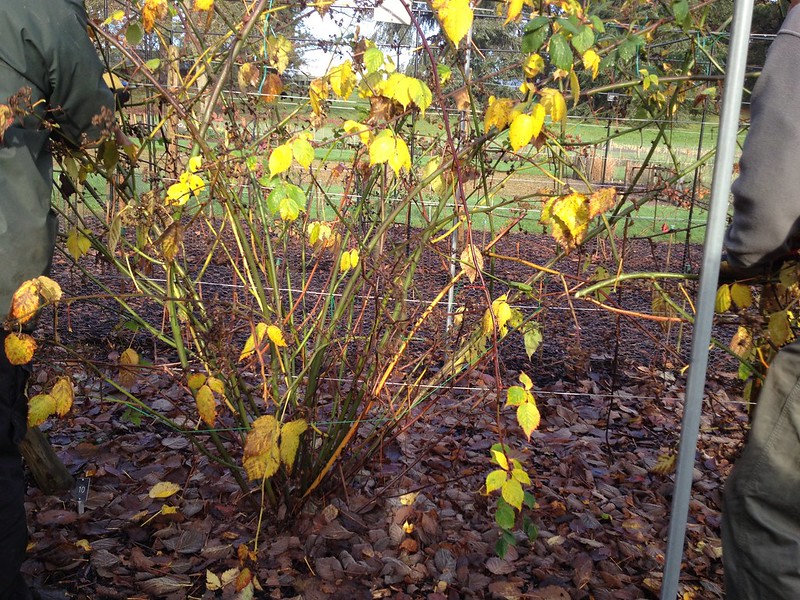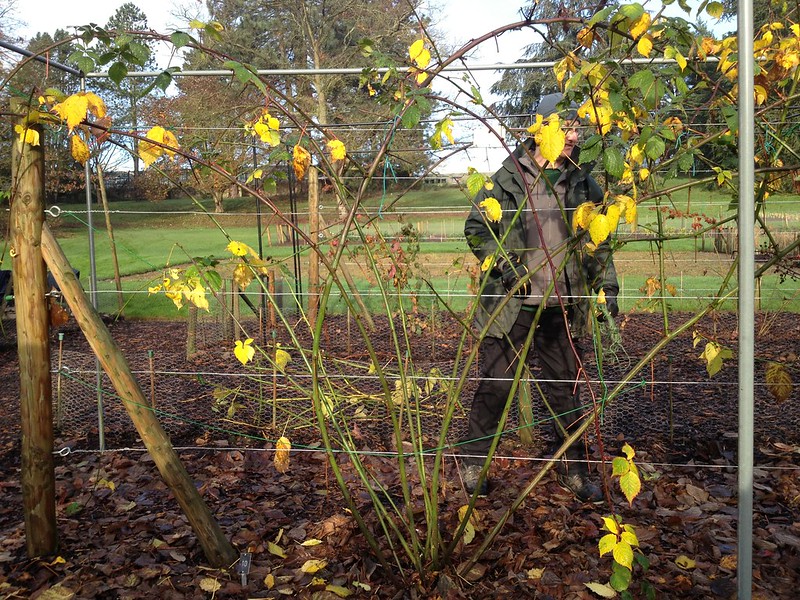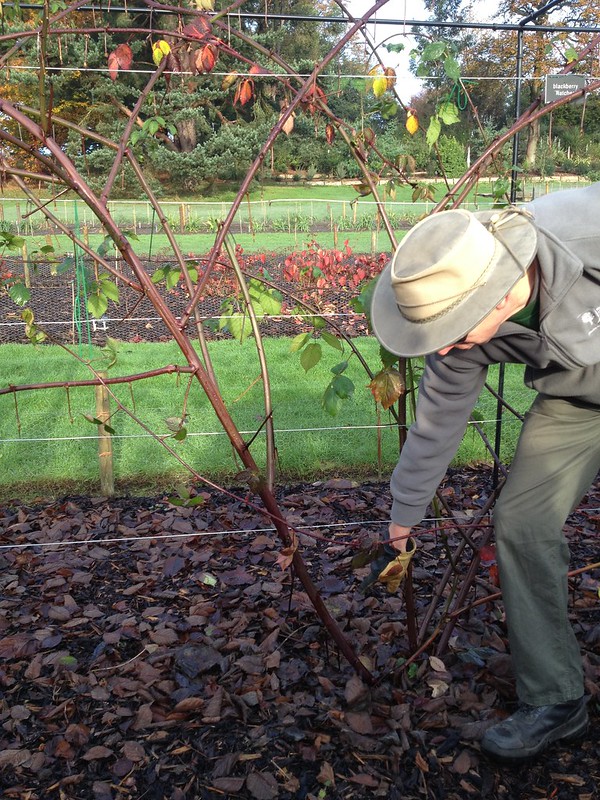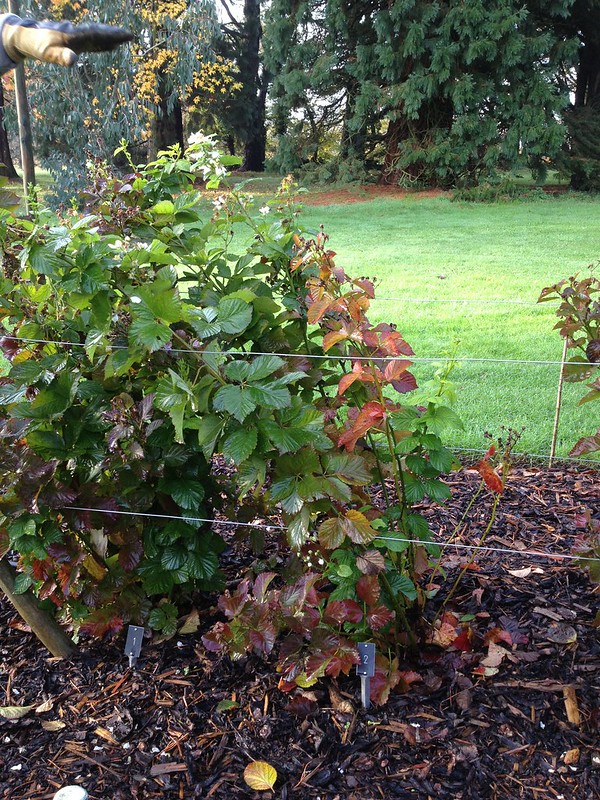- Boysenberry (R. ursinus x idaeus), originated in the US under the aegis of Rudolph Boyse, it is a cross between a loganberry, blackberry and European raspberry, can be spiny or spineless and has black fruits, tasting like a sweeter blackberry*
- Hildaberry
- King's Acre, an old hybrid of blackberry and raspberry with black fruits of mild flavour, suitable for a small garden
- Loganberry (R. × loganobaccus), with a sharp taste, loganberries (a cross between American blackberry and European raspberry, make a good culinary berry, which is sturdy and disease and frost resistant**
- Silvanberry (R. 'Silvan'), with an AGM, this Australian hybrid, very vigorous and spiny, it's early fruiting
- Sunberry, slow to establish but with large fruits, this hybrid has its origin in UK research centre East Malling****
- Tayberry (R. Tayberry Group), a patented hybrid, with juicy, aromatic berries, sweeter than loganberry
- Tummelberry, a patented hybrid, originally bred by the Scottish Crop Research Institute, this is a hardy tayberry with hairy canes, upright growth and sharper taste, more similar to the loganberry
- Veitchberry (R. inermis × idaeus) one of the older crosses, with stout canesand excellent flavoured fruits
- Wyeberry, developed at the University of Maryland, a hardier form of tayberry
- Youngberry, with round fruits and fewer seeds, this cross of loganberry and dewberry has never gained much popularity.
- American dewberry (R. trivialis), trailing and evergreen in their native countries, sweet and used by the natives as dyes; European dewberry (R. caesius)
- Japanese wineberry (Rubus phoenicolasius), with reddish, hairy stems and small light red berries
- Marionberry, a blackberry cultivar bred in Oregon ***
- Salmonberry (R. spectabilis) with perennial canes and orangey fruits, apparently eaten by the natives of the Pacific Northwest with salmon, best for culinary use
At RHS Garden Wisley some of those berries are being trialled, on a post and wire system, and we had the opportunity to work with them.
They are planted at 3 m apart (you could however use less for less vigorous and more for the bigger ones) and trained as a two-way rope system to 6 or so floricanes per side, set 15-20 cm apart on the three lowest wires, while the topmost one is kept free for new, primocanes to be tied in. Plants are lined up in order of ripening, for easier picking and management.
The pruning regime works as follows:
- tipping: when new canes have grown to some 30 cm, they are pinched back to 10-15 cm so they produce shorter, thinner canes when they regrow, which makes erect/semi-erect canes to be more flexible and manageable; this is not generally needed for the trailing varieties
- as they grow, primocanes are kept tidy with the use of strings, tied in the middle.
- after picking, fruited canes are pruned back to the ground: any stubs left are at risk of infection from cane blight (Leptosphaeria coniothyrium), besides being an obstacle to new canes, causing twisting and rubbing wounds (that may also act as nesting sites for the raspberry cane midge, which is associated with cane blight infection)
- in the autumn, primocanes are laid out to replace the fruited floricanes on the lower wires, tied in the first instance with knots in the figure of 8 (knot away from the branch), on the side of the prevailing wind, trying to get them in the direction they want to go. Short laterals are shortened to 3 buds (longer ones may be kept entire). When the branches are all satisfactorily laid out, 15-20 cm from each other and evenly space on both sides, they are laced in, as it's done with raspberries.
 |
| A rather vigorous, semi-erect cultivar of hybrid berry |
 |
| The fruited and damaged canes are pruned back to the ground |
 |
| Laying out the best primocanes for fruiting next year |
 |
| Ready for lacing |
 |
| An erect cultivar with laterals |
 | ||
| A trailing, less vigorous cultivar, ready for nex year |
 |
| Primocane fruiting blackberries |
As part of the trials, we were shown some primocane-fruiting blackberries that were bred in Arkansas, USA, which flower and fruit on top of the canes in their first year, and are therefore managed like autumn-fruiting raspberries, pruned in February and trained in between parallel wires. They should be quite easy to pick, however, fruits do not seem to be quite ripening in the short English summers, so more breeding will be needed before gardeners in the UK can make productive use of such new cultivars.
HDC released a cane management brochure, which has convenient diagrams for all the various support systems, and tying in and lacing techniques.
Sources and footnotes:
- Hessayon Dr D.G. (2012) The Fruit Expert, London: Expert Books
- University of Vermont Extension, Dept, of Plant and Soil Science http://perrysperennials.info/articles/lesserbram.html
** T&M http://www.thompson-morgan.com/fruit/fruit-plants/other-berry-plants/loganberry/cww3569TM
*** Oregon Raspberry & Blackberry Commission http://www.oregon-berries.com/pick-a-berry/
**** Blackmoor Nursery http://www.blackmoor.co.uk/products/447
No comments:
Post a Comment